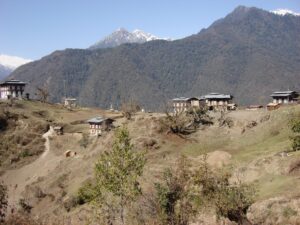Documentation of Kurtöp

Landing page image for the collection “Documentation of Kurtöp”. Click on image to access collection.
Summary of the collection
This collection is one of the first documentation efforts of Kurtöp, an endangered language of Lhüntse, Bhutan. It includes audio and video files of the language as spoken by its speakers from a wide variety of backgrounds and experiences between November 2005 to January 2009. The audio and video files comprise of conversations, interviews, narratives, storytelling, singing and elicitation, including files used for acoustic study.
The various foci of the recordings include historical information, religion, storytelling, agriculture, local culture, ceremony and flaura and fauna. In addition, over one thousand photographs accompany the recordings.
Group represented
The people who speak Kurtöp as their first language call themselves Kurtotpa, or the people from the upper Kur valley. There are three other languages spoken in this same valley, and in order to distinguish which “Kurtöp” speakers might clarify by saying ‘au gemale’, which is the way to say “where are you going?” in the language. People can also use the term ‘Zhake’, but this appears to be an arcane term today. The term Kurtöp comes from Dzongkha and has been applied by western linguists exclusively for this language.
Collection contents
This collection holds approximately 1200 audio files and over 300 files. The genres range from elicitation and controlled words for acoustic analysis to naturalistic story telling, songs and conversation. The data are more or less balanced between those recordings who were collected by outside researchers and those who were collected by local Kurtöp speakers. The topics range from local village life (subsistence, local flora and fauna, carpentry, etc), personal narratives and local histories to songs and oral performances that are religious or spiritual in nature. Most of the data were collected between 2005 and 2009 but some additional recordings from 2021 are included. There are also over 500 photographs
Special characteristics
This collection presents a very large body of data collected by local community members themselves. A comparison between data collected by locals versus what is collected by outsider researchers (western foreign researchers but especially mainstream Dzongkha-speaking Bhutanese) can show large differences in phonological (e.g. example presence of front-rounded vowels in higher registers), lexical (e.g. presence of honorific vocabulary in higher registers), and grammatical structures (e.g. different TAME suffixes depending on speech act participants) and as such is an important point of difference to be documented in the language.
Another special feature of this collection is the focus on local flora terms, which are all being linked to scientific botanical names in the trilingual dictionary.
Collection history
This project began as a field methods class at the University of Oregon in 2005, under the direction of Spike Gildea and Scott DeLancey. However the bulk of the data comes from collection that was supported by an ELDP Individual Studentship (IGS0049) awarded to Gwendolyn Hyslop in 2007. Most of the fieldwork took place in 2008. In addition to the project holder, Karma Tshering also helped collect data and recruit assistants for the project. The project closed in 2010 but as work on Kurtöp has continued some newer recordings are also included. Transcription was done using the program Transcriber in 2007-2009. Most of the transcriptions were completed by trilingual Kurtöp/English/Dzongkha speakers but the researcher(s) also transcribed several recordings as well.
Other information
The orthography used in the transcriptions is the proposed Kurtop Roman orthography, based on Romanised Dzongkha (see Tshering and van Driem 2019). The development and use of the Kurtöp orthography is explained in Hyslop (2014). It should be noted that, in spite of our attempts to perfectly teach the orthographic conventions to transcribers, there are likely to still be some mistakes. For example, the aspiration difference amongst voiceless palatals (c versus ch) is often missed, tone (represented with ‘) is often disregarded, and voiceless coronal stops (especially in coda position) are often represented as [th] rather than [t] (this is presumably to contrast them with the retroflex stops, which should be written as [tr] but sometimes written as [t]).
Acknowledgement and citation
Users of any parts of the collection should acknowledge the generous support of the Endangered Languages Documentation Programme as the funder for this project, as well as the institutional support from the Dzongkha Development Commission in Bhutan. Given what is said about some inconsistencies in orthography, users are urged to confirm transcription/pronunciation in the Kurtöp/English/Dzongkha dictionary and/or reach out to the grant holder (Gwendolyn Hyslop) with questions.
Data collected by G. Hyslop and K. Tshering.
To refer to any data from the collection, please cite as follows:
Hyslop, Gwendolyn. 2005. Kurtöp language documentation in Bhutan. Endangered Languages Archive. Handle: http://hdl.handle.net/2196/00-0000-0000-0009-4C2F-E. Accessed on [insert date here].




